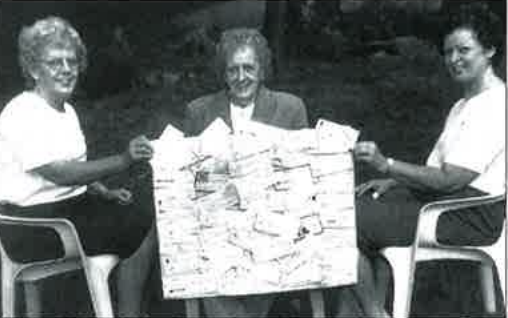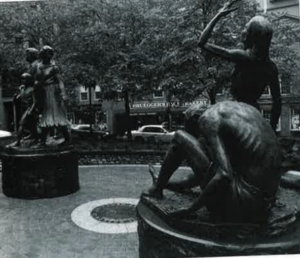Boston Irish Fight Today’s Famines
After building a $1 million memorial park last year to commemorate the 150th anniversary of the Irish Famine, Boston’s Irish community is turning its attention toward people suffering from contemporary famines throughout the world.
A proposed Irish Famine Institute that blends social activism and academic research is currently in the planning stages in Boston. Organizers want to create a permanent endowment to send food, medicine and supplies directly to African and Asian countries chronically experiencing famine and pestilence. The Institute also plans to support field research that will forecast and prevent famines in the future, and to educate the public about the hunger and suffering still occurring in the world.
The effort is being led by the founding chairman of Boston’s Irish Famine Memorial Committee, Thomas J. Flatley, a successful real estate developer who emigrated from Kiltimagh, Co. Mayo in 1950. Flatley has pledged the initial $1 million, and hopes to grow the endowment to $5 million over five years.
“The Irish have a long-standing tradition of helping those in need, as witnessed by the highly disproportionate number of Irish relief agencies and religious groups working in Africa, Asia, South America and elsewhere,” he said. “Irish Americans have also been extremely generous in funding a variety of programs in Ireland and Northern Ireland. We hope the Institute, based in America’s most Irish of cities, will continue this worthy tradition of reaching out to those who need us.”
Even though the Institute is not yet formally established, it has already made several donations, helping hurricane survivors in Central America. In May, the Institute made a $40,000 contribution to University College Cork’s International Famine Center, a well-regarded program that combines fieldwork and activism with scholarly research and public awareness.
Stephen Jackson, director of the UCC Center, is currently working with Kevin O’Neill, co-chairman of the Irish Studies Program at Boston College, to co-sponsor a major international conference on global food security, to take place at UCC next April.
Organizers want the Institute to serve as a “living memorial” to Ireland’s Great Hunger. That mission is permanently inscribed on the eighth and final narrative plaque that encircles the Boston Irish Famine Memorial in downtown Boston. The plaque reads: “The conditions that produced the Irish Famine — crop failure, absentee landlordism, colonialism, weak political leadership — still exist around the world today. Famines continue to decimate suffering populations. The lessons of the Irish Famine need to be continually learned and applied until history finally ceases to repeat itself.”♦
Famine Commemorations Around the World
The drive to commemorate the Great Famine and the global legacy of Irish immigration is swelling to massive proportions. Along with the new Irish Immigration postage stamp launched both in Ireland and the U.S. this year, and the increasing number of Irish Famine Curriculum Bills appearing before state legislatures, monuments commemorating the Famine and the Irish Diaspora are springing up throughout the world.
Joining those monuments already existing in New York, Boston, New Brunswick, Canada, and Ireland, a new memorial was dedicated in Phoenix, Arizona in September. Designed to resemble an ancient Celtic stone passageway, it symbolizes the passage from the old world to the new, from despair to hope, from oppression to freedom. It is located in Hance Park on the same site as the future Irish Cultural Center.

The An Gorta Mór Commemoration and Education Committee is currently conducting a campaign to erect a National An Gorta Mór Memorial in Chicago. It will be designed by artist Matt Lamb, who is also designing a national memorial in Skibbereen, County Cork, Ireland.
In Sydney, Australia, a monument to the Great Irish Famine was recently unveiled to an audience of 2,500. It is the largest piece of Australian public art dedicated to the legacy of Irish immigration and recounts the story of the thousands of teenage orphan girls who were sent to Australia from Irish workhouses during the famine. In a poignant reminder of the legacy of these girls and all Irish emigrants, several of the girls’ descendants participated in the unveiling ceremony, leading the opening procession and laying wreaths at the monument’s stone wall.
A unique feature of all of these commemorations is the increasingly popular idea of the “living memorial.” Not content with pieces of art commemorating past suffering, Irish organizations are mobilizing to relieve hunger throughout the world.
In White Plains, New York, work is underway to build The Great Hunger Memorial, which, along with artwork commemorating the famine, will also assist local not-for-profit organizations, like Meals on Wheels, to alleviate hunger in the community.
For more informaiton about the National An Gorta Mor Monument in Chciago, contact the group’s education committee at http://www.irishfamine.com or write 6438 N. Milwaukee Ave. Suite #199, Chicago, IL 60646-3728. For details on the Great Hunger Memorial in White Plains, New York call (914) 722-9071.♦


Leave a Reply